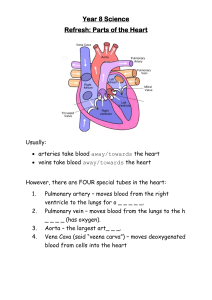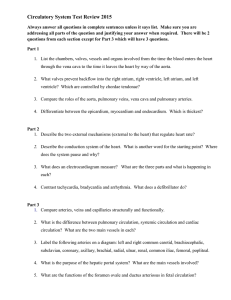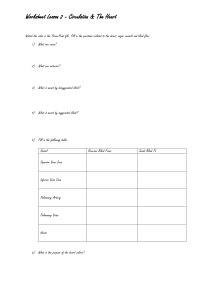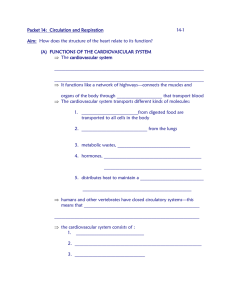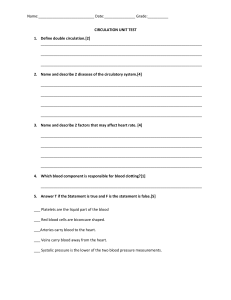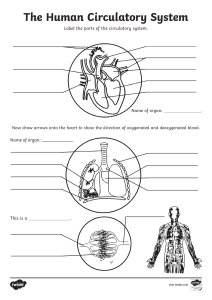Circulatory System: Blood Flow, Diseases & Healthy Habits
advertisement
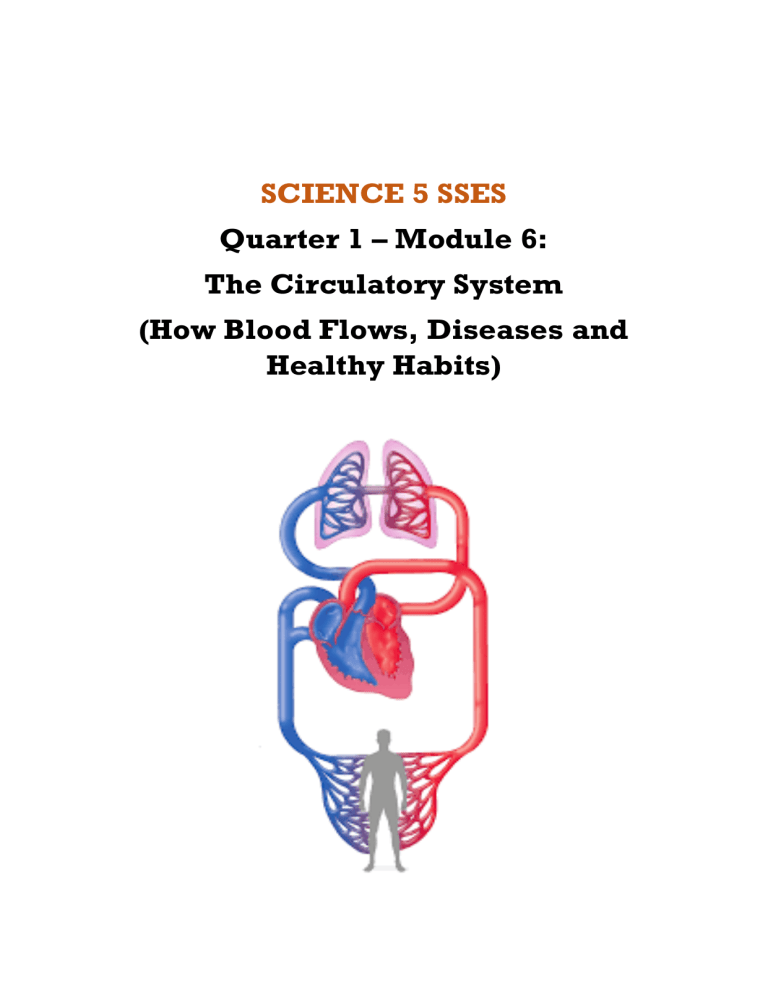
SCIENCE 5 SSES Quarter 1 – Module 6: The Circulatory System (How Blood Flows, Diseases and Healthy Habits) What I Need to Know After going through this module, you will understand how blood flows from the heart to the rest of the body, the common ailments of the circulatory system and the healthy habits you could do to maintain it. What I Know Identify what is/are asked. Write your answers on a separate sheet of paper. _______________1. It is the transport system of the body. _______________2. It is the liquid part that is constantly flowing throughout the body. _______________3. These are the smallest of formed components of blood that help in blood clotting. _______________4. It is the movement of deoxygenated blood from the heart and into the lungs. _______________5. It is the pumping organ of the body. 1 Lesson 1 How Blood Flows (Blood Circulation) In mammals, the circulation occurs in two circuits, and blood is circulated through the heart for two times. This type of circulation is called the double circulation. Pulmonary and systematic circulation are the two types of circulations that occur in a double circulation system. The difference between pulmonary and systemic circulation stems from the nature of the blood and the destination of the blood. The main difference between pulmonary and systematic circulation is that Figure 1: Diagram of the Pulmonary and Systemic Circuits pulmonary circulation carries deoxygenated blood from heart to lungs and oxygenated blood back to the heart whereas systemic circulation carries oxygenated blood from the heart throughout the body and deoxygenated blood back to the heart. What is Pulmonary Circulation Pulmonary circulation is the circulation system that carries deoxygenated blood to the lungs and returns oxygenated blood from the lungs back to the heart. The two blood vessels involved in the pulmonary circulation are pulmonary artery and the pulmonary vein. The deoxygenated blood flows into the right ventricle from the right 2 atrium. This blood is carried to the alveoli of lungs for the oxygenation by the pulmonary artery. The pulmonary artery, which immediately originates from the right ventricle, is called the pulmonary trunk. The pulmonary trunk divides into two; the left pulmonary artery and the right pulmonary artery. The left pulmonary artery carries blood to the left lung while the right pulmonary artery carries blood to the right lung. Figure 2: Pulmonary Circulation Carbon dioxide is removed from the blood while oxygen is taken into the blood at the alveolar capillaries. The oxygenated blood is carried to the left atrium of the heart by four pulmonary veins. A small amount of oxygenated blood is carried to the heart by the bronchial veins. What is Systemic Circulation The systemic circulation is the circulation system that carries oxygenated blood throughout the body and returns the deoxygenated blood to the heart from the body tissues. The oxygenated blood from the lungs returns to the left atrium of the heart through pulmonary veins. This blood flows into the left ventricle and comes out from the heart through the aorta. The aorta branches into small arteries, which carry blood to different organs in the body. Within an organ or tissue, these arteries branch to arterioles, which make blood capillaries. The exchange of oxygen and nutrients with the metabolizing cells occurs via blood capillaries. Carbon dioxide and other metabolic wastes are transported back to the blood. The deoxygenated blood drains back to the venules and returns to the right atrium of the heart by vena cava. The deoxygenated blood from the upper half of the body above 3 the diaphragm drains by the superior vena cava while the deoxygenated blood from the lower half of the body drains by the inferior vena cava. Figure 3: Difference Between the Pulmonary and Systemic Circulation 4 Study the flow chart below of how blood circulates through the heart: Figure 4: Circulation of Blood Through the Heart Lesson 2 Common Ailments of the Circulatory System The circulatory system is your heart and blood vessels, and it’s essential to keeping your body functioning. This finely tuned system carries oxygen, nutrients, electrolytes, and hormones throughout your body. Interruptions, blockage, or diseases that affect how your heart or blood vessels pump blood can cause complications such as heart disease or stroke. These complications can arise due to a variety of factors, from genetics to lifestyle. Read on to learn more about the types circulatory system diseases and disorders and what their symptoms are. 5 • High blood pressure Blood pressure is the measurement of how much force is used to pump blood through your arteries. If you have high blood pressure, also called hypertension, it means the force is higher than it should be. High blood pressure can damage your heart and lead to heart disease, stroke, or kidney disease. There are no symptoms with high blood pressure, which is why it’s often called “the silent killer.” • Atherosclerosis and coronary artery disease Atherosclerosis, also known as hardening of the arteries, occurs when plaque builds up on the walls of your arteries and eventually blocks blood flow. Plaque is made of cholesterol, fat, and calcium. Coronary artery disease indicates that the plaque buildup in your arteries has caused the arteries to narrow and harden. Blood clots can further block the arteries. Coronary artery disease develops over time. You can have it but not be aware of any symptoms. Other times, it may cause chest pain or the sensation of heaviness in the chest. • Heart attacks A heart attack occurs when not enough blood reaches your heart. This can happen due to artery blockage. Heart attacks damage the heart muscle and are medical emergencies. Call 911 or have someone else call if you have symptoms such as: - pain in the center or left side of the chest that feels like mild or severe discomfort, pressure, fullness, or squeezing - pain that radiates from the jaw, shoulder, arm, or across the back - shortness of breath 6 • - sweating - nausea - irregular heartbeat - unconsciousness Heart failure Sometimes called congestive heart failure, heart failure occurs when the heart muscle is weakened or damaged. It can no longer pump the volume of blood needed through the body. Heart failure normally occurs when you’ve had other heart problems, such as a heart attack or coronary artery disease. Early symptoms of heart failure include fatigue, swelling in your ankles, and increased need to urinate at night. More severe symptoms include rapid breathing, chest pain, and fainting. • Strokes Strokes often occur when a blood clot blocks an artery in the brain and reduces the blood supply. They also can happen when a blood vessel in the brain breaks open. Both events keep blood and oxygen from reaching the brain. As a result, parts of the brain are likely to be damaged. • Abdominal aortic aneurisms An abdominal aortic aneurism is a bulge in a weakened part of the aorta. The aorta is the largest blood vessel in your body. It carries blood from your heart to your abdomen, legs, and pelvis. If the aorta ruptures, it can cause heavy bleeding that’s life-threatening. • Peripheral artery disease Peripheral artery disease (PAD) is atherosclerosis that occurs in the extremities, usually in your legs. It reduces blood flow to your legs, as well as to your 7 heart and brain. If you have PAD, you’re at greater risk of developing other circulatory system diseases. What increases your risk of circulatory system diseases? Certain factors can increase your risk for circulatory system diseases. ➢ Modifiable risk factors are factors that can be controlled, changed, or treated with lifestyle changes. These risk factors include: o lack of exercise o being overweight o smoking o overuse of alcohol o high levels of stress o poor diet o Managing certain conditions such as high blood pressure and diabetes can also affect your risk. ➢ Nonmodifiable risk factors are risk factors that can’t be controlled, treated, or modified include: o advanced age o maleness o family history of heart disease, stroke, high blood pressure, or high cholesterol o certain ethnicities Lesson 3 Healthy Habits to Keep the Heart, Blood, and Blood vessels If you’re at risk for a circulatory system disease, work with your doctor to control conditions such as high blood pressure, high cholesterol, and diabetes. You can also take steps and make lifestyle changes to prevent these conditions. 8 √ Have a balanced diet each meal. A balanced diet gives you the correct food in proper amount. √ Watch your weight to prevent obesity. Obesity overworks the heart. √ Exercise regularly. You need active exercise to make your bones and muscles firm and strong. √ Have time to rest to keep your heart from breaking down from fatigue. √ Avoid stress. Avoid worrying too much. √ Do not smoke or drink liquor. √ Stay away from prohibited drugs. √ Get fresh air every day. The fresh air that you breathe gives quick help to the muscles of your heart. √ Stand and sit with good posture so that your lungs and heart have room to work properly. √ Visit the doctor at least once a year for a health examination. √ Reduce or Avoid Fatty Foods - Your body produces the right amount of cholesterol to maintain your health. Cholesterol is a fatty or oily substance that normally forms part of your cell wall. However, if the cholesterol level of your body gets high, it stays in the walls of the arteries. It contributes to the condition called arteriosclerosis or the hardening of the arteries causing heart attacks and strokes. Fatty diets especially animal fats increase the cholesterol level. It is better to replace the fats with carbohydrates such as bread, potatoes, and rice. Eat less meat and more fish and poultry. Bad fats are found in beef, pork, lamb, processed meats such as hotdogs and meat loaves. 9 Assessment I. Identify what is/are asked. Write your answers on a separate sheet of paper. ___________________ 1. This is the circulation system that carries deoxygenated blood to the lungs and returns oxygenated blood from the lungs back to the heart. ___________________ 2. This is the circulation system that carries oxygenated blood throughout the body and returns the deoxygenated blood to the heart from the body tissues. ___________________3. It is the measurement of how much force is used to pump blood through your arteries. ___________________4. This heart ailment is also known as the “silent killer”. ___________________5. It is the fatty or oily substance that is normally forms part of the cell wall but when consumed in excess contributes to the condition known as arteriosclerosis. II. Using arrows, trace the path of blood from the heart to the rest of the body. Write your answers on a separate sheet of paper. The Path of Blood Tricuspid Valve Superior/Inferior Vena Cava Right Atrium Right Ventricle Left Atrium Rest of the Body Left Ventricle Pulmonary Valve Pulmonary Artery Aorta Lungs 10 ANSWER KEY I. 1. Pulmonary Circulation 2. Systemic Circulation 3. Blood Pressure 4. High Blood Pressure 5. Cholesterol II. The Path of Blood Tricuspid Valve Superior/Inferior Vena Cava Right Atrium Right Ventricle Left Atrium Rest of the Body Left Ventricle Pulmonary Valve Pulmonary Artery Aorta Lungs 11
